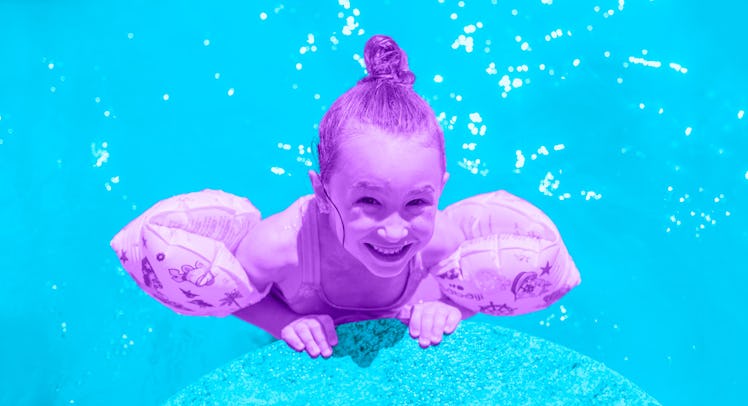The Best Swimming Games to Play With Kids Who Can’t Swim
Make the most of your time in the shallow end.

There’s no such thing as ‘relaxing’ time at the pool until your kid knows how to swim. Only when they can safely float, tread water, or launch an epic cannonball in the deep end can you truly grab a lounge chair and kick back for a nap. Until then, it’s sunscreen, life vest (or pool noodle), and an afternoon of bouncing around the shallow end.
For toddlers who can’t swim ⏤ or kids who are weak swimmers ⏤ wading into the water can be overwhelming. Not only does the shallow end offer a safer area to play, but being able to stand up does wonders for a child’s confidence. It also takes a bit of work off the parents, although it’s important to always have eyes on a child who can’t swim, no matter how many floatation devices they are wearing.
That said, the shallow end gets old fast. So to keep your little non-swimmer busy, without totally exhausting/boring you, we put together these five fun swimming games and activities.
Pool Painting
A great way to get kids who don’t love the water to spend time around the pool is by giving them a paint brush. Fill up a bucket of water (or encourage them to continually wet their paintbrush in the pool) and challenge them to ‘paint’ the edges of the shallow end while standing on the pool deck (or kiddie pool), racing against the sun on a hot day to finish the job before the water dries. Ask older children to write different letters, numbers, or even words on the pool deck. It’s all about getting them to spend more time around the water and to enjoy doing it.
Seal Play
A fun game for the swimmer who prefers to keep two feet planted firmly on the ground, give each child a beach ball and have them push it across the shallow end using only their nose, while they walk behind it. See who makes it to the other side first. Once they’ve mastered pushing the beach ball, have them blow the ball to the other side. This will get them thinking about blowing bubbles ⏤ an important step in learning to swim. If there are no other kids to compete against, turn it into an individual time trial and see how fast your little seal can go. This is a great option
Treasure Hunting
Drop toys that sink (dive sticks, rings, plastic animals, coins, or even a full treasure chest) into the water where a child can pick up the objects, either on a shallow step or a little deeper if you want them to practice putting their head underwater. The game can be a contest if you have multiple swimmers ⏤ see who can pick up the most items, or who can get all of their items first ⏤ or a simple challenge if your child is swimming solo. Simply start a timer to see how long it takes to pick up all of the treasure. You can also make it more challenging by asking your treasure hunters to pick coins up using only one hand or to retrieve dive sticks with their toes.
Wake Zone
This game lets your kid pretend to be a boat and comes in two versions, kicking and walking. The rules are simple: “Wake Zone” means go and “No Wake” means stop. If you make splashes in a no wake zone, you’re out. As the parent, you take on the role of the Harbor Master, shouting “Wake Zone” or “No Wake.”
For the walking edition, kids walk across the shallow end and see who can get to other end first. When you call “Wake Zone” they can run, trying to make as much progress as possible before you yell “No Wake,” when boats must stand as still as possible until the waves die down. To play the kicking version, kids hold onto a kickboard. When a “Wake Zone” is called, the water becomes a splash zone, and kids should kick vigorously. But when “No Wake” is declared, the pool should become still. The game goes on until the last boat makes it to the finish line.
Sea Monkey Says, Sea Monkeys Do
This aquatic adaptation of ‘Simon Says’ is a good way to encourage a nervous child to try the things they might otherwise be scared to do in the water. Designate one kid as the lead Sea Monkey, or take on the role yourself. The Lead Sea Monkey gives out directions, seeing which other Sea Monkeys can listen closely for the “Sea Monkey says” command, before following instructions. For example, Sea Monkey says, “Dip your left ear in the water.” Sea Monkey says, “Jump on one foot.” Sea Monkey says, “Blow nose bubbles.” Sea Monkey says, “Turn around.” Hop forward! Sea Monkey didn’t say “Hop forward!” The list goes on and the options increase along with the swimmer’s confidence.
Since you never want to send a child out of the pool (always keep them in the water), they become a Silly Sea Monkey when they make a mistake and complete only the activities that lack a “Sea Monkey Says” directive. The last Sea Monkey to become a Silly Sea Monkey wins!
Cathleen Pruden is a four-time All-American swimmer at Mount Holyoke College and the Assistant Swim Coach at Bowdoin College. She spent five years as the Head Coach of a summer league swim team for children ages 4- to- 18-year-olds and has taught over 600 private swim lessons to children and adults of all ages.
This article was originally published on